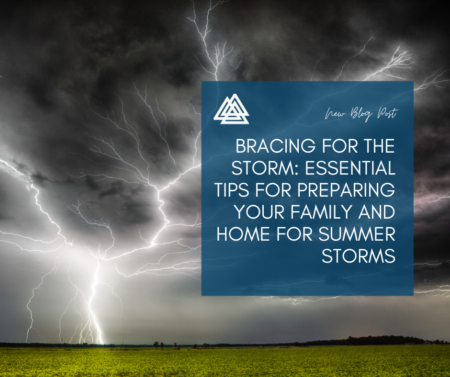 Summer storms can be unpredictable and sometimes severe, bringing heavy rains, strong winds, lightning, and even tornadoes or hurricanes. Preparing your family and home for these storms is essential to ensure everyone’s safety and minimize damage. This guide provides essential tips for storm preparedness to help you brace for the summer storm season.
Summer storms can be unpredictable and sometimes severe, bringing heavy rains, strong winds, lightning, and even tornadoes or hurricanes. Preparing your family and home for these storms is essential to ensure everyone’s safety and minimize damage. This guide provides essential tips for storm preparedness to help you brace for the summer storm season.
Understanding Summer Storms
Types of Summer Storms
Summer storms come in various forms, each with its own set of challenges:
- Thunderstorms: Characterized by lightning, thunder, heavy rain, and gusty winds. They can lead to flash flooding and power outages.
- Tornadoes: Violently rotating columns of air that can cause significant destruction. Tornadoes often accompany severe thunderstorms.
- Hurricanes: Large, powerful storms with high winds and heavy rainfall. Hurricanes can cause widespread damage and flooding over large areas.
- Flash Floods: Sudden, intense flooding caused by heavy rainfall. Flash floods can occur with little warning and pose a significant threat to safety.
Preparing Your Family
Create an Emergency Plan
An emergency plan ensures that every family member knows what to do when a storm hits:
- Communication Plan: Establish how you will communicate if family members are separated. Ensure everyone has important phone numbers.
- Meeting Points: Designate safe areas in your home for different types of storms (e.g., a basement for tornadoes) and a meeting place outside the home in case of evacuation.
- Evacuation Routes: Familiarize yourself with local evacuation routes and have a plan for where you will go if you need to leave your home.
Assemble an Emergency Kit
Prepare an emergency kit with essentials to sustain your family during and after a storm:
- Water: At least one gallon of water per person per day for three days.
- Non-Perishable Food: A three-day supply of food that doesn’t require refrigeration.
- First Aid Kit: Include bandages, antiseptics, medications, and any necessary medical supplies.
- Flashlights and Batteries: Ensure you have extra batteries on hand.
- Radio: A battery-powered or hand-crank radio to stay updated on weather alerts.
- Personal Items: Toiletries, clothing, blankets, and important documents (e.g., IDs, insurance papers).
Stay Informed
Keep informed about weather conditions and warnings:
- Weather Apps: Install weather apps on your phone for real-time updates and alerts.
- NOAA Weather Radio: A weather radio provides continuous updates and emergency alerts.
- Local News: Monitor local news stations for updates on storm conditions and safety information.
Preparing Your Home
Secure Outdoor Items
Strong winds can turn outdoor items into dangerous projectiles:
- Bring Inside: Move patio furniture, grills, and toys indoors or secure them.
- Anchor Structures: Secure larger structures, like sheds or gazebos, to the ground.
Protect Windows and Doors
Prevent damage from flying debris and high winds:
- Storm Shutters: Install storm shutters or board up windows with plywood.
- Reinforce Doors: Ensure doors are sturdy and can be securely fastened.
Maintain Trees and Landscaping
Proper landscaping can reduce storm damage:
- Trim Trees: Remove dead or overhanging branches that could fall during a storm.
- Secure Loose Items: Remove or secure loose landscaping materials.
Prevent Flooding
Take steps to minimize the risk of flooding:
- Clear Gutters: Ensure gutters and downspouts are free of debris to allow proper drainage.
- Check Sump Pump: Test your sump pump to ensure it’s working correctly.
- Seal Leaks: Inspect your home for leaks and seal any cracks in the foundation or walls.
During the Storm
Stay Indoors
Remain inside during the storm and away from windows and doors:
- Seek Shelter: Move to a safe area, such as a basement or interior room, especially during tornado warnings.
- Avoid Electrical Appliances: Do not use electrical appliances or take a shower during a lightning storm.
Monitor Weather Alerts
Continue to monitor weather alerts and updates throughout the storm:
- Emergency Radio: Keep your battery-powered radio on for the latest information.
- Cell Phones: Use your phone for updates, but conserve battery power.
After the Storm
Assess Damage
Once it’s safe to go outside, carefully assess any damage to your home and property:
- Check for Hazards: Look for downed power lines, broken gas lines, and structural damage.
- Document Damage: Take photos of any damage for insurance purposes.
Stay Safe
Ensure your family’s safety as you begin to recover from the storm:
- Avoid Floodwaters: Do not walk or drive through floodwaters, as they may be contaminated or conceal hazards.
- Use Generators Safely: If using a generator, ensure it’s outside and well-ventilated to avoid carbon monoxide poisoning.
Seek Assistance
Reach out for help if needed:
- Contact Authorities: Report downed power lines, gas leaks, and other hazards to local authorities.
- Insurance Claims: Contact your insurance company to start the claims process for any damage.
Summer storms can be intense and unpredictable, but with proper preparation, you can protect your family and home. By creating an emergency plan, assembling an emergency kit, staying informed, and taking steps to secure your property, you can minimize the impact of storms and ensure everyone’s safety. Remember, preparation is key to weathering the storm and emerging with sun-kissed memories intact.
